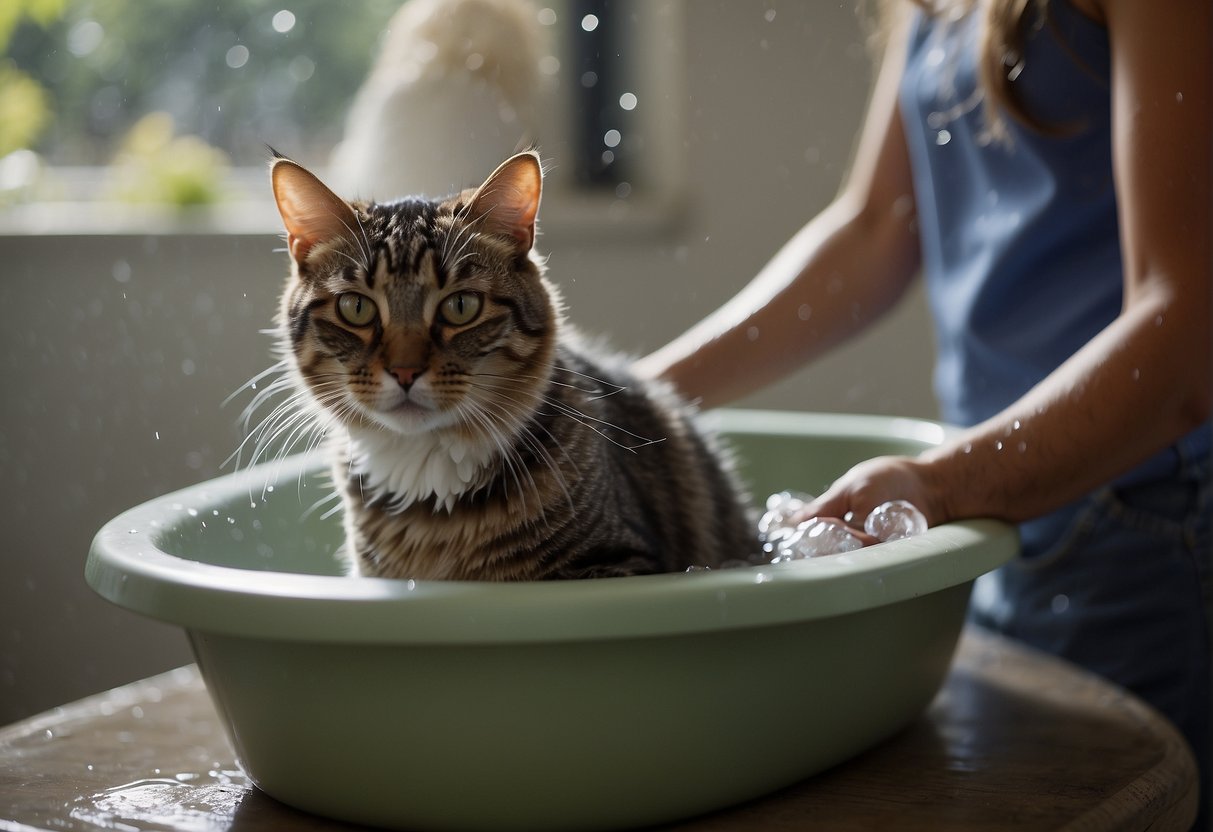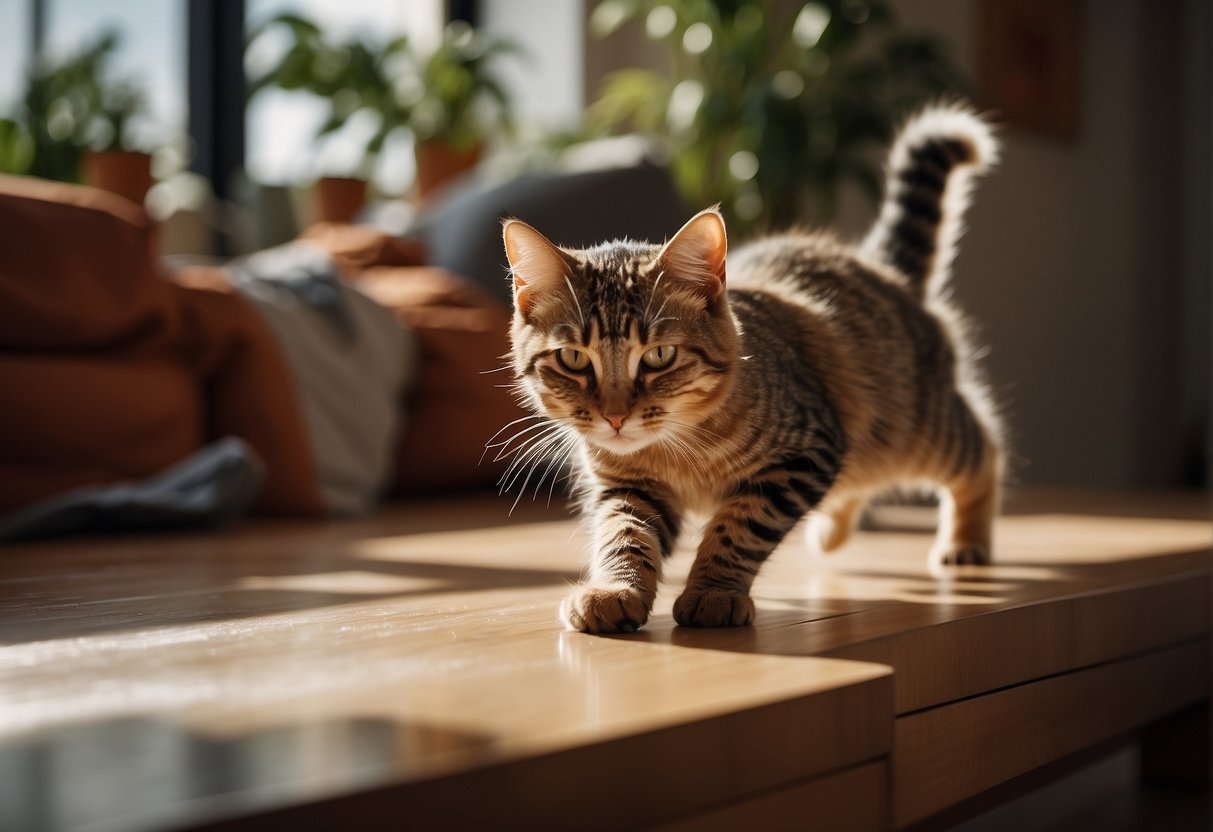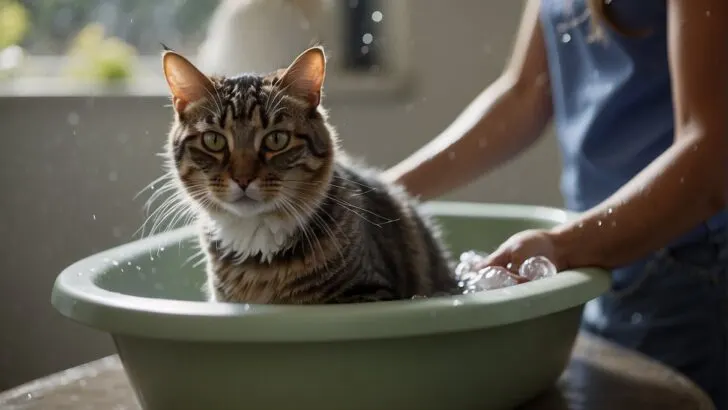Getting skunk smell off a cat can be a challenging but necessary task if your feline friend has had an unfortunate encounter. If you’re a cat owner, you know the curiosity of cats can sometimes lead them into trouble, like coming too close to a skunk.
In my own experience, understanding that a quick response is critical has helped alleviate the stress of these smelly situations. Acting fast minimizes the discomfort for your cat and the time the odor lingers in your home.

Navigating through the overpowering scent that a skunk leaves behind on your cat requires specific steps. It’s important to recognize that common myths, such as using tomato juice, are ineffective and can also be messy.
Instead, practical knowledge leads us to more effective solutions that neutralize the odor rather than just masking it. I’ve learned that preparing a homemade mixture of baking soda, hydrogen peroxide, and dish soap is usually the key to success, saving both my cat and my household from days of enduring the skunk stench.
When your cat has been sprayed by a skunk, the oil-based skunk secretion binds to their fur, making it difficult to remove. Traditional pet shampoos usually fall short in these situations, so having the right homemade remedy to break down the oils and neutralize the odor is vital.
You also want to take care to protect your cat’s sensitive eyes, nose, and mouth during the cleaning process.
Immediate Steps After Skunk Spray

When your cat has an encounter with a skunk, immediate action is crucial to minimize the potent skunk odor, which is caused by thiol compounds in the spray. Quick response can also prevent prolonged discomfort for your pet.
Assess the Situation
First, confirm that the foul odor your cat is emitting is indeed from skunk spray. Skunks will release a spray—a pungent mix of thiol compounds—that can cling to your cat’s fur.
Check for any signs of distress or irritation, particularly around the eyes and mouth, as skunk spray can cause discomfort. Keep your cat calm, as stress can exacerbate the situation.
Protect Yourself and Your Cat
Before starting the cleaning process, take precautions:
- Wear rubber gloves to protect your hands from the skunk oil and odor.
- Isolate the sprayed area to keep the odor contained, preferably outdoors or in a well-ventilated room.
- Check your cat’s face for signs of irritation or exposure, especially the eyes. If they’ve been hit, gently flush them with water to ease any discomfort.
Initial Cleaning
Timing is key—start the cleaning process as soon as possible to neutralize the odor.
- Prep a cleaning solution using:
- 1 quart of 3% hydrogen peroxide
- 1/4 cup of baking soda
- 1 to 2 teaspoons of mild dish soap like Dawn
This mixture helps break down the thiol compounds responsible for the skunk odor. However, don’t store or bottle this solution, as it can build up pressure and burst.
- Apply the solution to your cat’s fur, avoiding the eyes and mouth.
- Rub the mixture through the fur and onto the skin where the skunk spray hit, as the oil can be present even in areas that don’t smell as strongly.
- Rinse thoroughly with water after allowing the mixture to sit for about five minutes to neutralize the odor, then follow with a pet-friendly shampoo.
Deodorizing and Bathing
When your cat has an unfortunate encounter with a skunk, proper deodorizing and bathing are crucial to neutralize the skunk odor and restore your cat’s coat to its natural state.
Pre-Bath Treatments
Before you start the actual bath, it’s important to neutralize the skunk odor. A commonly recommended pre-bath treatment is a mixture of 1 quart of 3% hydrogen peroxide, 1/4 cup of baking soda, and 1 teaspoon of liquid dish detergent like Dawn. This homemade de-skunking solution helps break down the skunk oil and reduce odor before the bath.
- Do not wet your cat first; apply the mixture to the dry fur for optimal effectiveness.
- Avoid the eyes and mouth to prevent irritation, and use a washcloth for the facial area.
- After application, let the solution sit for about 3 to 5 minutes.
Bathing Process
Once the pre-treatment has done its job, it’s time to give your cat a thorough bath:
- Use a cat-specific shampoo to ensure the product is safe and designed for their fur.
- Lather generously, working the shampoo into the fur to clean out any residual skunk oil.
- Rinse thoroughly to ensure all soap and remaining odor are washed away.
- Repeat if necessary, as skunk odor can be particularly stubborn.
Safe Bathing Products
It’s essential to use safe products on your cat to avoid any skin irritation or adverse reactions:
- Feline-friendly shampoos are specially formulated for a cat’s sensitive skin.
- DIY mixtures using baking soda, hydrogen peroxide, and dish soap can be effective, but never use them without proper dilution.
- Avoid human shampoos and other harsh chemicals, as they can harm your cat’s skin and fur.
In the case of skunk encounters, it’s generally not recommended to use tomato juice, as this is a myth and not as effective as the hydrogen peroxide and baking soda mixture.
Post-Bathing Care
After a thorough bath to remove skunk spray, it’s crucial to pay attention to your cat’s post-bathing needs to ensure their comfort and health.
Eye and Mouth Care
If your cat’s eyes or mouth came into contact with skunk spray, they could experience irritation or even potential injury. Immediately after the bath:
- Eyes: Gently flush your cat’s eyes with saline solution to alleviate any irritation. Watch for signs of redness or excessive tearing, which may indicate a more serious issue like corneal injuries.
- Mouth: If your cat is showing signs of drooling, foaming, or vomiting, these could be indicative of nausea caused by ingesting the spray. Offering fresh water helps, but consult your vet if these symptoms persist.
Monitoring for Health Issues
Skunk spray contains sulfur compounds that may cause health issues beyond initial irritation. Post-bathing, closely monitor your cat for:
- Respiratory Problems: Sneezing or difficulty breathing could signify the spray has affected their airways. Contact your vet if you notice any changes in breathing.
- Skin Reactions: Even after a bath with hydrogen peroxide, your cat’s skin may remain sensitive. Look out for persistent scratching or signs of irritation.
- Anemia: In rare cases, skunk spray can lead to anemia. Symptoms like lethargy and pale gums warrant a vet visit.
- Vaccination Check: If your cat was near a skunk, ensuring their rabies vaccine is up to date is crucial for their health and peace of mind.
Preventing Future Skunk Encounters
After you’ve managed to remove that pesky skunk odor from your cat, preventing further skunk encounters is crucial. Securing your outdoor spaces and properly training and supervising your pets can save you from another stinky situation.
Securing Outdoor Spaces
Backyard Safety: Begin by examining your yard for any potential entry points. Skunks can squeeze through small spaces, so ensure all gaps under your porch, deck, shed, or fence are blocked with chicken wire or hardware cloth.
It’s preferable to bury it a few inches into the ground as skunks are quite the diggers.
Fortify Structures: Assess structures like your shed or porch. If they’re raised, it’s important to make them skunk-proof by sealing them off. This will deter skunks who look for shelter to make a home beneath them.
Training and Supervising Pets
Leash Training: When outdoors, especially during dawn or dusk when skunks are most active, keep your cat or dog on a leash. It’s not just about control, but prevention. This restricts them from chasing after wildlife, including skunks.
Vaccination Advice: Since skunks are potential carriers of rabies, it’s critical to keep your pet’s vaccines up to date. While this won’t prevent skunk encounters, it reduces the risk of serious health issues if there is an unexpected interaction.

My name is James, and welcome to FAQCats!
Along with our team of cat owners, expert pet enthusiasts, and pet professionals, we aim to write engaging helpful, engaging content about cats. At FAQCats we strive to provide content that’s accurate and fun to read. Our team writes about everything related to cats; even the most complex of topics. Through extensive research and caring for our own fur-pals, we’re able to provide something cat owners worldwide will love. Have a look around, and leave us feedback anytime!

